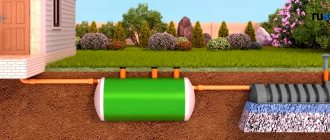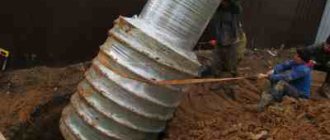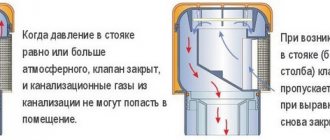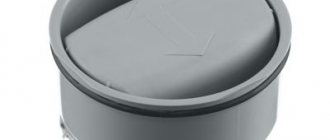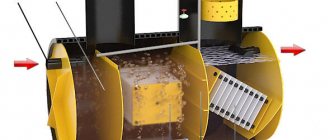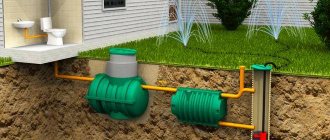Cleaning a septic tank from sludge: when is it necessary?
The recycling station accumulates fecal waste and food waste. A large amount of organic residues accumulates in it. Special microorganisms take an active part in processing. As a result of fermentation, rotting and oxidation, harmful gases are formed. Therefore, it is recommended to equip pits without a concrete bottom.
At the moment, cesspools can be used if additional equipment for biotreatment is available. Special bacteria process fecal waste, which allows the output to be purified liquid, industrial water, which can be used for watering vegetation. In some cases, special chemicals are now used to clean sewers and cesspools. If you add them to the sewer, the number of cleanings can be significantly reduced, but you cannot do without them completely.
The frequency of cleaning the septic tank depends on the size and operating characteristics of the unit. For example, if the container has a volume of 2 cubic meters. meters, and 3 people live in a residential building, cleaning will have to be done every two years. However, experts recommend removing sludge regularly, namely every year. This greatly simplifies the procedure for cleaning equipment from impurities.
Frequency of cleaning of the treatment plant
The frequency of the storage tank cleaning procedure directly depends on the intensity of use of the autonomous sewage system, as well as the volume of the tank.
In private housing developments where people live permanently, it is recommended to clean the septic tank twice a year, taking into account the average waste processing time of about six months. When using seasonal drainage, the sump tank must be cleaned before completion of operation.
It is worth understanding that excessively frequent pumping of sludge has a negative impact on the functioning of the treatment plant; the quality of wastewater treatment deteriorates due to the removal of anaerobic bacteria during the procedure.
Therefore, before cleaning the existing septic tank, it is worth periodically replenishing the population of microorganisms, which allows pumping to be carried out once a year (preferably at the end of the autumn period).
How to determine that a septic tank needs to be cleaned of sludge
In cases where water begins to flow poorly through the pipes, this may indicate a blockage and a large accumulation of sludge in the disposal unit. If insects are found above the drain, this may also indicate contamination. Also, an unpleasant odor may indicate that the contents of the biological station need to be pumped out. Unpleasant gases that accumulate in the sewer can be returned through the pipes to the cottage. This smell can have a negative impact on your well-being. The poisonous gas is very dangerous for humans and the environment.
In all these cases, timely cleaning of the septic tank and possibly even complete cleaning of the contents is required.
Signs of siltation
The most obvious sign of siltation in a cesspool is a decrease in its volume. As a result, it fills up faster and sewage pumping is required more often.
Other signs indicating siltation include the following:
- The appearance of an unpleasant odor. Near the pit you can hear it almost constantly, but if it suddenly intensifies and is present throughout the entire yard, this is a clear signal.
- The silt is visible through the inspection hatch. Also indicates the need to clean the pit.
The volume of the septic tank can also reduce fat deposits on the walls and bottom. Grease also prevents water from being absorbed into the soil, resulting in a shorter interval between pumpings. It can be removed using biological products.
Methods for cleaning a pit without pumping
Cesspools are often installed in various suburban areas. They are reliable and unpretentious. The key advantage of such models is ease of installation and quick commissioning time. Most often, sewage disposal equipment is used for cleaning. However, it is often not possible for special equipment to access the cesspool, so the question arises of how to clean the septic tank in a private house yourself, without resorting to the services of a vacuum cleaner. In this case, biological and chemical agents are used.
Biological cleaning agents
The mechanical method is not the most convenient due to cost and other external factors. Therefore, various biological preparations are used. Their advantages include the fact that they:
- Allows you to minimize the volume of fecal matter.
- They disinfect sewage, making it harmless to the environment.
- The unpleasant smell disappears.
Biological components for cleaning septic tanks are produced from special bacteria. Here are their main differences from natural microorganisms:
- Special microorganisms can only survive in certain conditions.
- To carry out full life activities, a liquid environment is necessary.
- Low temperatures can lead to the death of cultured bacteria.
If you regularly add biological products, you can greatly simplify the cleaning of the septic tank. It will be enough to pump out sludge and feces once every two to three years. Special microorganisms demonstrate their effectiveness in summer, autumn, and spring.
Today, manufacturers offer a wide variety of biological products, including Ecorecycle, Bioexpert and others. Their advantages include the fact that they do not harm insects, pets and the environment.
Chemicals
Special chemical components are often used to clean septic tanks and outdoor toilets. In the past, preparations based on formaldehyde compounds were used for these purposes. However, formaldehyde is hazardous to health. Therefore, today they use chemicals based on nitrogen oxidizers and ammonium compounds. They have proven their effectiveness.
Chemicals based on ammonium compounds are considered less toxic, but they are not harmless to the environment and the human body. Products based on nitrogen oxidizers are considered safer. Their composition is very similar to nitrogen fertilizers that are grown for agricultural plants.
Problems in cold and frosty seasons
Cleaning sewer pits in autumn and winter can be complicated for two reasons.
- Low temperature leads to a decrease and complete stop of the activity of beneficial bacteria, which accelerates the process of formation of sludge masses and complicates their removal.
- In the case where there is an initially incorrectly equipped cesspool, CLEANING it, and not only cleaning, but also functioning, can be complicated by freezing. If the design is correct, with sufficient depth, that is, below the freezing level, as well as with insulation and thermal insulation of the top layer, such problems do not arise even in severe frosts. The heat released during the process of exothermic biodecomposition is enough to maintain a positive temperature. Unless a thin crust of ice may form on the surface. If something was done in bad faith, technological errors were made during the arrangement and freezing occurred, emergency measures will be needed. Heating methods such as a heat gun, a blowtorch, or a steel rod heated by electricity are used. In the end they just pour boiling water. But the best and easiest way is a special “Anti-Ice” product, which melts ice and snow and prevents them from forming.
Pros and cons of nitrogen oxidizers
- High efficiency even when exposed to household chemicals.
- The best decomposition of organic matter.
- Excellent removal of unpleasant odors.
The only disadvantage is the high cost. Chemicals based on nitrogen oxidizers are often used to dissolve sludge and settled solids. They are very successful in neutralizing dangerous bacterial environments.
The most popular are chemicals based on nitrate oxidizing agents. These include “Devon-Il”. Their regular use will turn the contents of the septic tank into a safe substance, which can subsequently be poured into a compost pit.
How to clean with household chemicals
A septic tank product in the form of chemicals made from a nitrate oxidizer is the most effective and environmentally sound treatment of wastewater from autonomous sewer systems, especially in winter.
It is not difficult to organize the process of cleaning the sump with your own hands, by consistently following the recommendations of the instructions for a particular product.
Cleaning concrete structures is a complex process, unlike plastic septic tanks. On the walls of the chambers, grease and other waste deposits are retained due to the porosity of the material and are removed after complete decomposition.
To speed up waste processing, it is important to select preparations that are compatible with septic tank materials to clean the chambers of fatty deposits.
Knowledge of the use of chemical treatment products and the operation of treatment facilities will allow you to correctly select and use drugs that speed up the process of processing and purification of wastewater.
The use of chemicals to clean septic tanks from solid waste and grease deposits is especially important in winter, while microorganisms are preserved.
1. The chemical reagent "Devon-Il" helps remove plugs from sewage in the sewer system, dilutes hardened sludge deposits and waste.
For the effective action of the substance, in accordance with the instructions, you must:
- Pour 100 ml monthly into the home drain. Getting into the septic tank wells, it eliminates and dilutes solid waste and sludge;
- 0.5–1 l per 1 cubic meter. m of wastewater should be poured into the receiving chamber when pumping out liquid to neutralize the odor;
- pour 100–200 ml 3 times a day into the sewer system in the house or treatment facility to remove a large layer of silt or blockage.
Method for cleaning a storage septic tank without pumping
When carrying out the appropriate set of cleaning works, the following recommendations must be adhered to:
- Do not pour chlorine-containing components down the drain. Aggressive substances can lead to the death of the bacterial environment. Additionally, it is necessary to regularly inoculate the cesspool with microorganisms. To do this, it is necessary to pour out a sufficient amount of waste daily. Due to the fact that bacteria will remain on the walls of the pipes, grease deposits and food debris will be removed.
- It is necessary to leave a little sludge when removing bottom sediments. The sludge mass contains bacteria that are involved in the processing of organic matter. Upon completion of the cleaning procedure, it is recommended to replenish the container with special bacteria. You can purchase anaerobic bacteria in specialized stores.
- Regular use of chemicals will prevent silting of the disposal unit. When using them, you will be much less likely to have to call a sewer truck to clean the septic tank.
Mechanical cleaning
In most cases, sewage disposal equipment is called for this. The contents are pumped out using special equipment. On average, the procedure can take from 15 to 30 minutes depending on the volume of the reservoir and various external factors. In this case, you don’t need to think about where to drain the pumped-out substance.
However, in some cases it is necessary to clean the septic tank yourself. In this case, special drainage pumps are used. They are distinguished by high performance and reliability. With their help, you can easily pump out sludge. The main question that will definitely need to be resolved is where to drain the sewage. To transport the pumped-out substance, you will need to purchase a completely sealed container. This option is especially effective if there is no access for sewage disposal equipment to your territory.
In each case, you must follow the manufacturer's recommendations. It may not be practical to turn to a vacuum cleaner; it is easier to install a drainage pump to carry out the removal. Modern models can be equipped with a pump to remove liquid sludge. The sludge can be used to fertilize vegetation. More complete information can be obtained from specialists who will tell you how to use the sludge removal pump yourself.
Where is sodium hydroxide used?
More often, the product is used to eliminate severe pollution, as it dissolves dirt, grease, soot, soot, oil stains, etc. well. Alkali has the properties of neutralizing acid, and it also dissolves organic components contained in wastewater well. Due to this, it is effectively used for cleaning sewer pipes.
Using this method is as simple as possible. To do this, just pour the powder into the pipe, wait the specified time, and then rinse with plenty of running water. If necessary, the procedure is repeated.
Chemical and biological sludge removal
Removal of sludge using chemical and biochemical preparations is most often used as an additional method of servicing waste disposal units. The use of special preparations promotes oxidation and rapid decomposition of biological residues. Typically, ammonium sulfate or formaldehyde based components are used. The advantages include rapid decomposition; the disadvantages are that the purified liquid cannot be used for watering vegetation.
Biological preparations are quite effective in decomposing sludge. Their use allows you to speed up the processing of fecal wastewater. In order to minimize sludge pumping, it is recommended to regularly use biological products or chemicals. When using biological products, the purified mass can be poured into the ground without further treatment.
Briefly about the main thing
Siltation develops in all treatment systems; this happens for various reasons. An external sign of sludge accumulation is the rapid filling of the waste tank and increased pumping.
To solve the problem, you need to determine the cause of the blockages. At the first stage, they call the sewer trucks to pump out the septic tank. The remaining sludge is removed from the bottom and walls mechanically. Dense sludge can be broken down using chemical or biological preparations.
To prevent siltation from reoccurring, preventive measures are carried out; the most effective method is biological. If the cause of siltation was the excessive use of chlorine-containing household chemicals, it will be limited in the future.
Ratings 0
Effective cleaning of septic tank from sludge
When selecting a suitable biological station, it is important to consider not only the performance and operating principle. It is important that when cleaning fecal matter, the wastewater is divided into fractions, the solid fractions settle to the bottom, and the purified wastewater flows further into the drainage well or filtration fields. By using improved stations, the volume of incoming waste can be reduced, and sewerage equipment is usually called out every three to five years.
If the owner of a country house wants to minimize pumping of the septic tank, it is recommended to use special biological products. They contribute to the efficient processing of large fractions, and less sludge settles at the bottom. However, it is important to provide ventilation holes to ensure that gases escape.
Today modifications consisting of 2, 3, 4 cameras are popular. A multi-stage filtration system allows you to effectively clean wastewater. The purified liquid can be used to fertilize vegetation and other purposes. Additionally, filtration fields or wells can be constructed for additional cleaning.
The biostation is considered the most popular. It is suitable for both small country houses and cottages or townhouses. Automatic stations are becoming increasingly popular. Proper installation and compliance with operating conditions will ensure effective filtration and reduce the number of calls for vacuum cleaners. They are able to effectively purify wastewater; the purified liquid can be used for irrigation and fertilization. Our specialists will be happy to provide more complete information about each recycler. Additionally, they will tell you how to clean a septic tank without pumping it yourself. We guarantee high service.
Methods
All sewer cleaning methods are divided into two groups:
- chemical;
- mechanical.
A third group can be distinguished, combining the features of both chemical and mechanical effects. These include a folk remedy that involves mixing soda and vinegar directly in the drain of a sink or bathtub.
To prevent blockages, chemicals are used that can be found in any hardware store or supermarket. Their task is to clean the pipe walls from fatty films and solid sediment. Mechanical methods are suitable in any situation, even with minor blockages, even with the formation of a water-impenetrable plug. However, it is mechanical means that can harm the pipes themselves and their inner surface, which will cause further contamination to occur more actively.
So the general rule is that to prevent blockages, you should regularly use chemicals to keep the pipes clean and only if problems arise with drainage, when the water no longer goes away on its own, use physical force and forcefully break through the sewer.
Neutralization of acidic agents
The use of caustic is not limited to sewer cleaning. In particular, sodium hydroxide is used to neutralize strong acidic drain cleaners. If the remaining acid is not removed from the pipes, it will continue to act and can corrode the metal. Caustic soda completely neutralizes the acid without damaging cast iron or steel structures.
Caustic agents are also used in “shock wave” technologies for cleaning main pipelines.
The active substance successfully dissolves scale and is used both in everyday life and in welding pipelines, gas lines, and oil pipelines.
The duration of exposure to metal for a successful result is about 12 hours.
Diluting soda to flush the sewer pipe system
As mentioned earlier, there are three types in which this product is produced - liquid in the form of a gel or solution, solid in the form of a powder. “Mole” is purchased at a hardware store in a ready-made form, and pouring the solid substance into pipes is strictly prohibited; it must first be diluted. To do this, you will need 3-4 kg of soda, a device in the form of a spatula or scoop, and a metal or plastic container that will not be destroyed by the powder, since it is quite caustic.
To avoid damaging the skin of your hands, it is recommended to wear gloves, and to prevent the solution from getting on the mucous membranes, wear glasses. Pour the entire amount of soda bicarbonate with water in the amount of 7-7.5 liters of water and stir until it is completely dissolved. When combined with a liquid, the alkali begins to release a large amount of heat into the environment, so you need to know that the bucket with all its contents will heat up and may even become hot.
